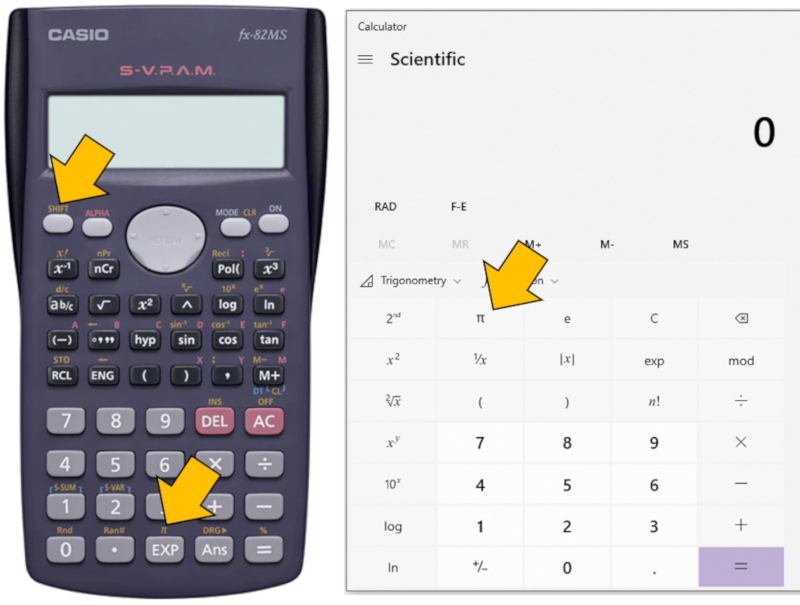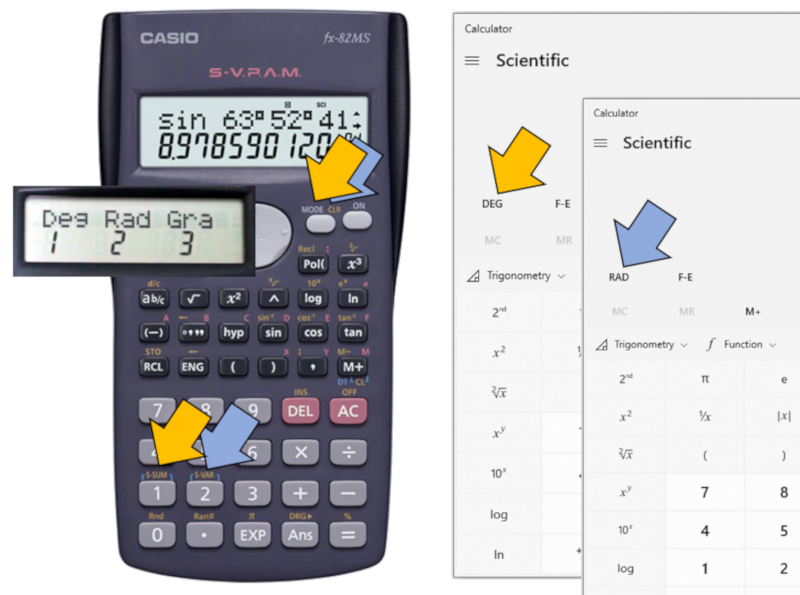Trigonometric Functions
Storyboard 
Trigonometric functions allow you to determine the angles of rectangular triangles based on their sides. In turn they allow the calculation of the sides based on other sides and angles of the triangle.
Otherwise, trigonometric functions can be used to describe physical processes that include oscillations.
ID:(425, 0)
Trigonometric functions
Definition 
Trigonometric functions allow the calculation of the angles of right triangles, or having the angles, calculate the legs of the triangles.
ID:(495, 0)
Value of PI
Image 
Si se requiere el valor de Pi se puede generar el valor con la calculadora:

Hay que tener cuidado que al usar un numero de pocos digitos se puede afectar el resultado del calculo.
ID:(13969, 0)
Calculation in radians and degrees
Note 
In many cases it is necessary to work with radians instead of degrees. In these cases it is necessary to configure the calculator so that what is entered or this output corresponds to radians or degrees.
To configure the calculator you must locate the function for it. In many, the mode (RAD or DEG) is defined or there is a selection between the two modes:

GRDs do not correspond to degrees, it is a decimal measure in which the 90 degree angle is defined as 100.
ID:(13968, 0)
Trigonometric Functions
Storyboard 
Trigonometric functions allow you to determine the angles of rectangular triangles based on their sides. In turn they allow the calculation of the sides based on other sides and angles of the triangle.\\nOtherwise, trigonometric functions can be used to describe physical processes that include oscillations.
Variables
Calculations
Calculations
Equations
Examples
Trigonometric functions allow the calculation of the angles of right triangles, or having the angles, calculate the legs of the triangles.
Si se requiere el valor de Pi se puede generar el valor con la calculadora:
Hay que tener cuidado que al usar un numero de pocos digitos se puede afectar el resultado del calculo.
In many cases it is necessary to work with radians instead of degrees. In these cases it is necessary to configure the calculator so that what is entered or this output corresponds to radians or degrees.
To configure the calculator you must locate the function for it. In many, the mode (RAD or DEG) is defined or there is a selection between the two modes:
GRDs do not correspond to degrees, it is a decimal measure in which the 90 degree angle is defined as 100.
The relationship between
Two angles
The relationship between the angle
To calculate the corresponding function can be used
The relationship between the angle
To calculate the corresponding function can be used
The relationship between the angle
To calculate the corresponding function can be used
The relationship between the angle
The cotangent is the inverse function to the tangent function.
The tangent function is written according to the cosine and the sine by:
Pythagoras obtains the relationship between the cosine and the sine of an angle
The angle
The
To calculate the corresponding function can be used
The angle
The
To calculate the corresponding function can be used
The angle
The
To calculate the corresponding function can be used
The angle
The
The sine of the sum of two angles can be written according to the cosine and sine of the individual angles:
The cosine of the sum of two angles can be written according to the cosine and sine of the individual angles:
The tangent of the sum of two angles can be written according to the cosine and sine of the individual angles:
ID:(425, 0)
